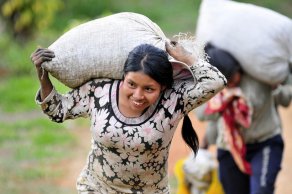
Photo: Neil Palmer (CIAT)
Over the last decade, Colombia has been host to the world’s largest population of internally displaced people (IDP). In 2016, it is expected that the Colombian government and FARC will reach a peace agreement, marking the formal end of more than 50 years of civil war. It is widely recognized that this peace agreement will not resolve the immediate causes of displacement, but rather generate one kind of settlement in a context of longstanding and complex uses of violence.
At present, contradictory tendencies seem to be at play: While periods of 2015 have seen the lowest levels of violence recorded on a national level since 1975, threats against civil society actors are increasing at an alarming rate.
As academics, we should be prepared to contribute to the development of a positive peace that amounts to more than the absence of armed conflict. We must continue to research, analyze and theorize violence against grassroots activists; in particular we must make sense of the type of gendered threats and gendered violence female activists are subjected to. From a socio-legal perspective, I think two challenges are particularly significant here.
First, that our theoretical tools for making sense of a violent post-conflict setting are underdeveloped. Existing theories of uses of law by social movements tend to be based on the legal cultures and institutions of industrialized liberal democracies.
In a recent article in Law and Society Review on IDP organizing in Colombia, Julieta Lemaitre and I argue that in violent contexts, mobilization frames are unstable and constantly shifting, resources tend to vanish, and political opportunities often imply considerable physical danger. In recent years, the legal and political conceptualization of the IDP situation as a humanitarian crisis has given way to a transitional justice frame. Yet, the challenges of violent context persist, with additional violence resulting from the ongoing land restitution process. We suggest that future research must pay attention to how legal mobilization in a social context that will most likely remain violent develops under a post-conflict legal regime, for various groups of women’s grassroots activists, including but not limited to displaced women.
Second, in particular, it will be necessary to do a better job of accounting specifically for the persistence of gendered violence and the ways it interlinks with grassroots women’s organizing. For example, Goldstein and Arias influential idea of “violent pluralism” as a mode of describing the Latin American and Colombian experience with conflict and violence is silent on the gendered realities of this violence. In the post-conflict setting, we need to get a better understanding of political and legal mobilization in response to gendered violence; gendered violence as an obstacle to such political and legal mobilization; and how political and legal mobilization become the causes of gender-based violence.
Continued gendered violence will be a serious threat to positive peace. Taking the New Year’s resolution seriously involves figuring out what’s new, what’s old and which stories have not yet been told. In particular, it involves a commitment to resist the danger of (English-language) scholarly amnesia that often follows watershed moments like this type of peace agreement. It also includes being cognizant of the existing gaps in knowledge that are not going away with a peace agreement.
Happy Holidays.
- This text was first published at the IntLawGrrls blog 11 Dec 2015.